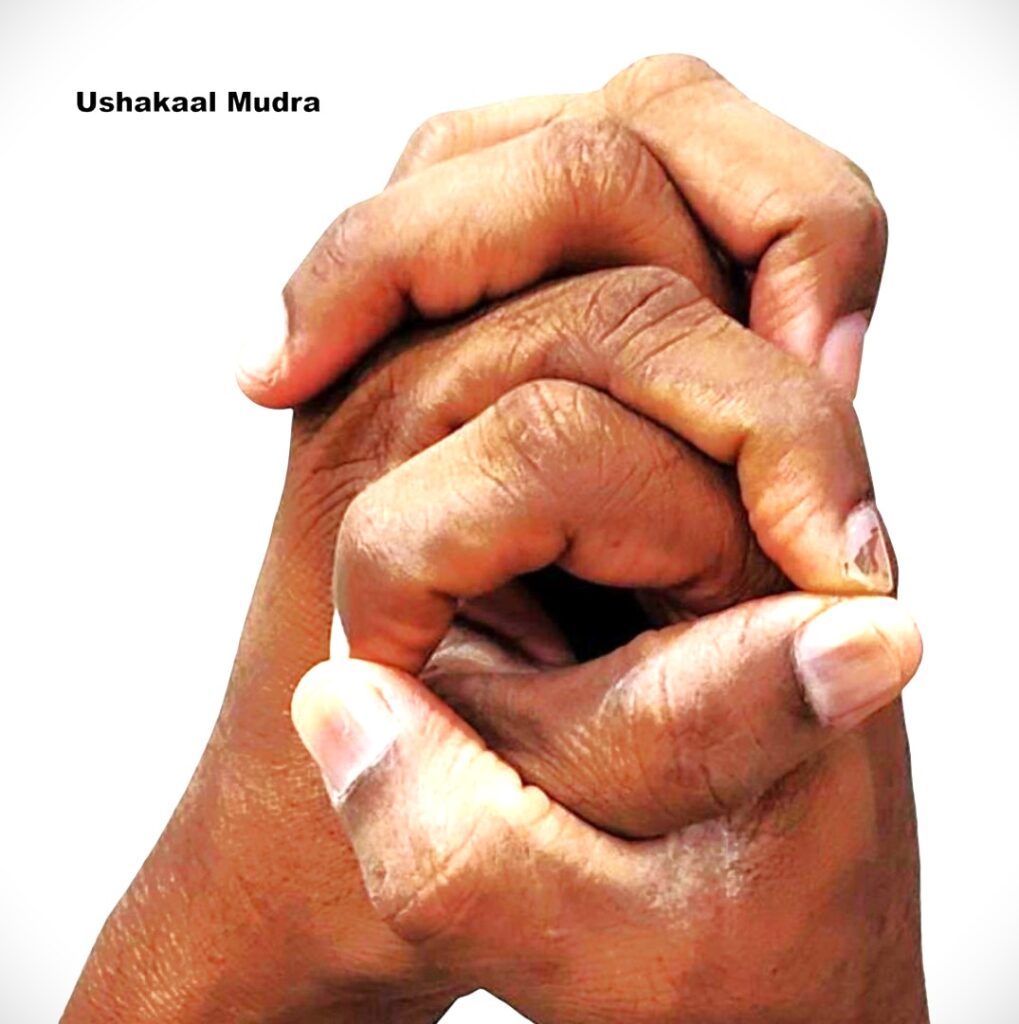Ushakaal Mudra
Introduction
Ushakaal Mudra is a subtle hand gesture in yoga designed to stimulate energy flow, support mental focus, and enhance vitality. It is believed to balance the body’s energy channels, promoting clarity of mind and overall wellness.
The term Ushakaal combines Usha, meaning dawn or new beginning, and Kaal, meaning time or energy cycle, reflecting the mudra’s purpose of revitalizing energy and promoting a fresh, balanced state of being. It is often incorporated in meditation, pranayama, and yoga therapy practices.
Meaning
Usha: Dawn, new beginning, vitality.
Kaal: Energy cycle, time, rhythm.
Mudra: Gesture to channel energy flow.
Overall Meaning:
Ushakaal Mudra symbolizes renewal of energy and mental clarity, enhancing vitality and focus while supporting emotional and energetic balance.
How to Perform / Practice
Sit comfortably in a meditative posture (Padmasana, Sukhasana, or on a chair) with an erect spine.
This Mudra can be performed while being seated, in a standing position or lying in bed.
Concentrate on your breathing to relax and feel comfortable. Clasp both your hands together as shown in the image.
Please note that the left index figure is on top of the right index finger.
Now, bring the tips of the Index finger and Thumb of the respective hands closer, but do not let them touch, simply form an open circle.
Maintain the mudra for 15–30 minutes daily, or 5–10 minutes in shorter sessions.
Tip: Ideal for morning practice to stimulate energy and focus for the day ahead.
Benefits
Physical Benefits:
Enhances overall vitality and energy levels.
Supports metabolism and organ function.
Reduces fatigue and improves circulation.
Mental & Emotional Benefits:
Improves concentration, mental clarity, and focus.
Reduces stress, anxiety, and mental fatigue.
Encourages emotional stability and calmness.
Energetic / Spiritual Benefits:
Stimulates upward and balanced pranic flow.
Supports meditation, mindfulness, and mental alertness.
Promotes a sense of renewal, positivity, and energetic harmony.
Contraindications
Avoid if experiencing hand or finger injuries.
Not recommended for severe arthritis or joint pain in fingers.
Discontinue if numbness, tingling, or discomfort occurs.
Anatomy & Physiology
Muscles: Engages intrinsic hand muscles (lumbricals, interossei) and forearm muscles to maintain the mudra.
Joints: Flexion at little and ring fingers; extension at index and middle fingers.
Nervous System: Activates parasympathetic system for relaxation while supporting focused alertness.
Circulation: Enhances microcirculation in hands and fingers; indirectly supports energy flow throughout the body.
Kinesiology
Improves fine motor coordination and finger dexterity.
Enhances neuromuscular communication between hands and brain.
Supports static postural stability during seated meditation.
Neurology
Stimulates brain regions responsible for alertness, focus, and energy regulation.
Balances sympathetic and parasympathetic activity, reducing mental fatigue while enhancing vitality.
Supports neural plasticity, improving mental clarity, concentration, and emotional resilience.
Duration of Practice
Daily Practice: 15–30 minutes, can be divided into 2–3 sessions.
Short Practice: 5–10 minutes during meditation, work breaks, or energy rituals.
Can be combined with pranayama or other mudras for enhanced effect.
Counter Mudra
If energy becomes excessive or restless, switch to Gyan Mudra or Chala Mudra.
Gentle hand stretching or shaking is recommended to release tension after prolonged practice.
Conclusion
Ushakaal Mudra is a simple yet effective hand gesture to revitalize energy, enhance focus, and balance mental and emotional states. Regular practice harmonizes physical, mental, and energetic systems, making it a valuable tool for meditation, yoga therapy, and daily wellness. Proper execution ensures maximum benefits without discomfort.
FAQ
Q1: Can beginners practice Ushakaal Mudra?
A: Yes, it is safe and simple; start with 5–10 minutes and gradually increase.
Q2: Can it improve energy levels and focus?
A: Yes, it stimulates upward and balanced pranic flow, enhancing vitality and mental clarity.
Q3: Can it be combined with other mudras?
A: Yes, often combined with Dhyana Mudra, Prana Mudra, or Gyan Mudra during meditation.
Q4: Is it suitable for morning practice?
A: Yes, it is ideal for morning practice to invigorate the mind and body.
References
Swami Satyananda Saraswati, Mudras for Healing and Transformation.
Iyengar, B.K.S., Light on Yoga.
Saraswati, S., Pranayama and Mudras in Yoga Therapy.
Fishman, L., Yoga for Emotional Balance.
Journal of Bodywork and Movement Therapies, 2018; 22(4): Effects of Hand Mudras on Mental and Physiological Functions.

